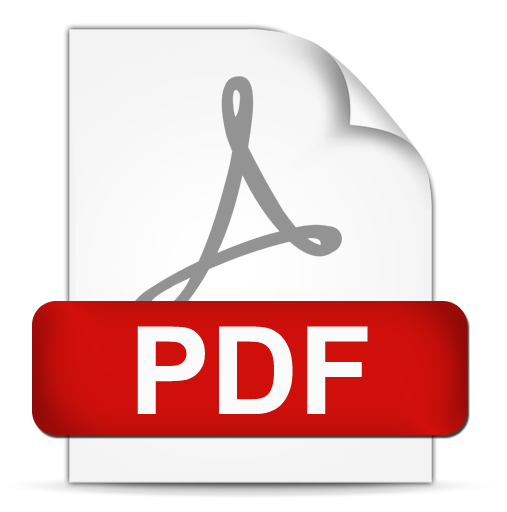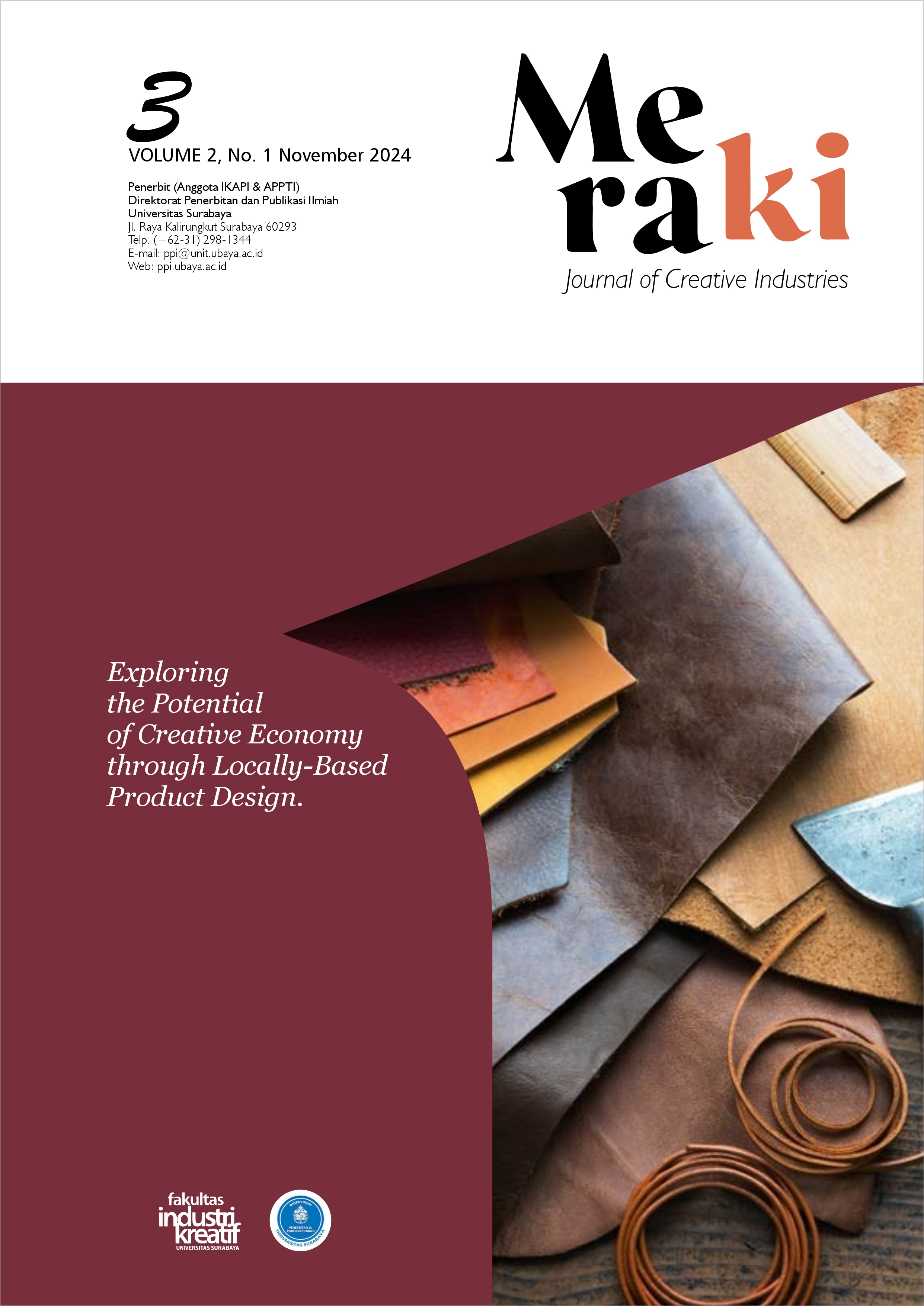Potensi Penggunaan Limbah Kulit Menjadi Aksesoris
Indonesia
 Abstract Views:
307 times
Abstract Views:
307 times
 PDF Downloads:
256 times
PDF Downloads:
256 times
Abstract
considering the nature of leather waste which is difficult to decompose and the widespread production of
leather products in Indonesia has resulted in a large amount of leather waste not being recycled. This
research aims to explore the potential for using leather waste in making accessories, with a focus on
developing appropriate methods and processes. The methodology includes qualitative analysis of the
characteristics of leather waste and observation of its potential as an accessory material. The main findings
include identifying the types of leather waste that are most suitable for making accessories, as well as
determining optimal processing techniques. In conclusion, managing leather waste for making accessories
has significant potential and can be an important step in efforts to reduce waste and increase the
sustainability of the leather industry.
Downloads
References
animal skin identified by palaeoproteomics in Scythian leather objects from Ukraine. PLOS
ONE, 18(12), e0294129. https://doi.org/10.1371/journal.pone.0294129.
[2] Fisher, O., Watson, N., Porcu, L., Bacon, D., Rigley, M., & Gomes, R. L. (2018). Cloud
manufacturing as a sustainable process manufacturing route. Journal of Manufacturing
Systems, 47, 53–68. https://doi.org/10.1016/j.jmsy.2018.03.005.
[3] Hossain, M., & Zami, S. A. (2021). LEATHER WASTE INTO VALUE ADDED LEATHER
PRODUCTS: A WASTE TO WEALTH APPROACH.
[4] Simeonova, L. S., & Dalev, P. G. (1996). Utilization of a leather industry waste. Waste
Management, 16(8), 765–769. https://doi.org/10.1016/S0956-053X(97)00020.
[5] Setyowati T. Nurdiana Wijayanti F. Pemberdayaan Ekonomi Pengrajin Batik Eco Print
Yang Berdaya Saing Dimasa New Normal Covid 19. Vol. 7. Jurnal Pengabdian
Masyarakat Ipteks. 2021.
[6] Rahmawati, R., Goestjahjanti, F. S., Handayani, S. R., Soenarto, S., Bandi, B., Djuminah, D.,
Hartoko, S., Budiatmanto, A., Airawaty, D., & Arifah, S. (2022). Inovasi Pewarnaan Alam
Copyright © 2023, author, e-ISSN XXXX-XXXX, p-ISSN XXXX-XXXX
7
MERAKI: Journal of Creative Industries, Vol.xx No.x, April xxxx, pp. XX-XX
Pada Kulit Sapi Strategi Peningkatan Omset BUCINI. Jurnal Pengabdian Masyarakat
Progresif Humanis Brainstorming, 5(3), 557–565. https://doi.org/10.30591/japhb.v5i3.369
[7] Roy, U. (2003, October 1). Analysis of leather processing needs of small tanneries and
probability of common finishing facilities center.
https://www.semanticscholar.org/paper/Analysis-of-leather-processing-needs-of-small
and-Roy/c493d5e94bf6dc52134e2a69a0d3f5578f56d147
[8] Sandin, G., & Peters, G. M. (2018). Environmental impact of textile reuse and recycling – A
review. Journal of Cleaner Production, 184, 353–365.
https://doi.org/10.1016/j.jclepro.2018.02.266
[9] Putratama, N. G. (2016). Analisis Pengendalian Kualitas Guna Mengurangi Tingkat
Kegagalan Produk Kulit Grade Super pada UD. Mitra Usaha.
https://www.semanticscholar.org/paper/Analisis-Pengendalian-Kualitas-Guna-Mengurangi
pada-Putratama/21b7f36d969e47d7f96d4f792251e2caa6748402
[10] Saputra, A. S., & Al Faritsy, A. Z. (2023). ANALISIS KUALITAS PRODUK PENYAMAKAN KULIT
MENGGUNAKAN SEVEN TOOLS. Jumantara Jurnal Manajemen Dan Teknologi Rekayasa,
2(1), 8. https://doi.org/10.28989/jumantara.v2i1.1430
[11] Musattak, T. R. (2005). PROSES PENGOLAHAN KULIT SAPI SECARA NABATI
MENGGUNAKAN BAHAN PENYAMAK KAYU AKASIA DI UD PENYAMAKAN KULIT ‘HM
SUWARNO’NGARIBOYO -MAGETAN. https://www.semanticscholar.org/paper/PROSES
PENGOLAHAN-KULIT-SAPI-SECARA-NABATI-BAHAN-DI
Musattak/b489ac73471949bb55f5b33863d181d21f01f5e7
[12] Simeonova, L. S., & Dalev, P. G. (1996). Utilization of a leather industry waste. Waste
Management, 16(8), 765–769. https://doi.org/10.1016/S0956-053X(97)00020-2
[13] Brun, A., & Ciccullo, F. (2022). Factors affecting sustainability-oriented innovation in the
leather supply chain. Strategic Change, 31(3), 305–321. https://doi.org/10.1002/jsc.2500
[14] Persson, L., & Rundqvist, M. (2006). Designing new leather products by utilizing waste
material. https://urn.kb.se/resolve?urn=urn:nbn:se:ltu:diva-53594
[15] F. Nugrahani and M. Hum. Metode Penelitian Kualitatif. Solo: Cakra Books, 2014.
[16] C. Semiawan. Metode Penelitian Kualitatif. Grasindo, 2010.

This work is licensed under a Creative Commons Attribution-ShareAlike 4.0 International License.
- Copyright on articles is retained by the respective author(s), without restrictions. A non-exclusive license is granted to Keluwih: Jurnal Sains dan Teknologi to publish the article and identify itself as its original publisher, along with the commercial right to include the article in a hardcopy issue for sale to libraries and individuals.
- Articles published in Meraki: Journal of Creative Industries are licensed under a Creative Commons Attribution-ShareAlike 4.0 International license. You are free to copy, transform, or redistribute articles for any lawful purpose in any medium, provided you give appropriate credit to the original author(s) and the journal, link to the license, indicate if changes were made, and redistribute any derivative work under the same license.
- By publishing in Meraki: Journal of Creative Industries, authors grant any third party the right to use their article to the extent provided by the Creative Commons Attribution-ShareAlike 4.0 International license.

 DOI:
DOI:


